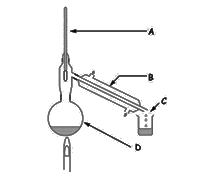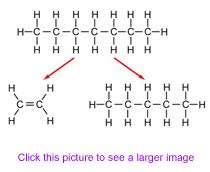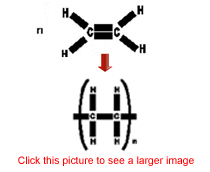

An oil platform at sea drilling for crude oil. Learn more about crude oil with this quiz.
Crude Oil 2
Crude oil, also called petroleum, is formed from the anaerobic decay of dead sea creatures and plants when sediments become buried deep beneath the sea bed. It becomes trapped beneath impervious rock and is extracted by drilling oil wells. The crude oil that is released by drilling is very thick, viscous and fairly useless because it is a mixture of hundreds of different hydrocarbons, mainly of the alkane family. Extra processing such as fractional distillation and cracking is required to extract and process these before the oil becomes useful.
The many hydrocarbons in crude oil may be separated into fractions, each of which contains molecules with a broadly similar number of carbon atoms. This is achieved by evaporating the oil and allowing it to condense at a number of different temperatures. This process is called fractional distillation and takes place in a fractionating column. For your GCSE exam, you need to know and understand the main processes in continuous industrial fractional distillation. You will also need to be able to demonstrate that you know the shorter chain hydrocarbons are obtained from higher in the column and vice-versa. You may also find it useful (but it's not essential) if you are able to remember the names and uses of the fractions.
Once the fractions have been separated and stored, some of them can be processed further. In most crude oils, the proportions of the different fractions that are produced don't usually match the demand. For example, an oil refinery may find that almost 40% of the oil they pass through the fractionating column is from the residue fraction. If they can only sell half of this, they have a dilemma (called overproduction) about what to do with the unsold material. Similarly, they may find that only 5% is the fraction that they can sell as petrol for cars. They could probably sell a lot more than that so again, they have a problem (this is called underproduction). Both problems are solved by thermal catalytic cracking. They take the unsold residue, which contains long chain hydrocarbon molecules and break them down into shorter chain molecules like petrol.
One of the by-products of cracking is molecules of a family of chemicals that is not naturally found in crude oil - the alkenes. These are unsaturated molecules (contain a double bond between at least one pair of carbon atoms) that are more reactive than the original alkanes. The main things that you need to know about these are that the simplest alkene is ethene, that they will discolour bromine water and can join together to form extremely long molecules called polymers.


Ready for more?
not all...
quizzers. Try to win a coveted spot on our Hall of Fame Page.









